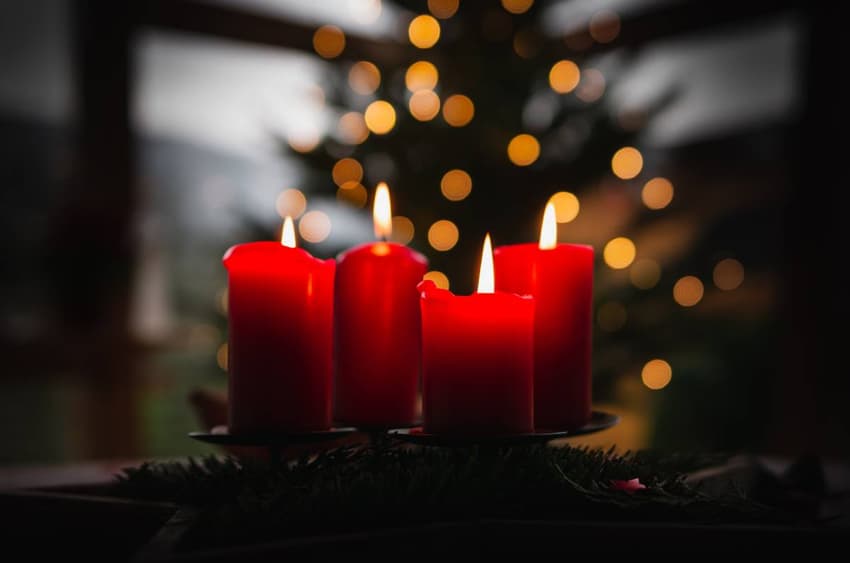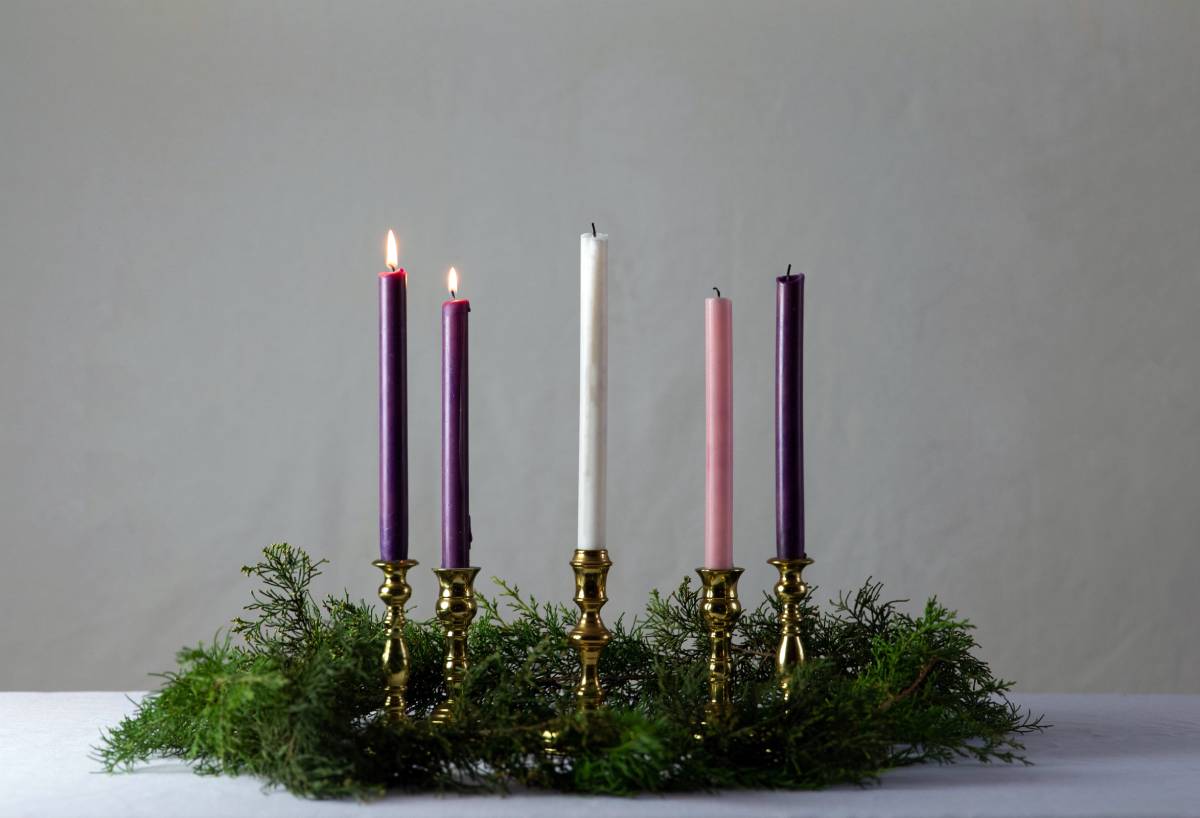Why do the Nordic countries light candles on each Sunday of Advent?

The tradition of lighting candles during Advent in the Nordics has a rich history that stretches back centuries.
In modern Nordic countries, the tradition of lighting candles during the Advent period is relatively widespread.
This practice, rooted in the region's culture, pays homage to the Advent wreath's symbolism – and builds up excitement and anticipation in the run-up to Christmas.
But what makes this practice so deeply embedded in the Nordic region to the extent that it surpasses its popularity in anglophone countries?
Origins of the Advent candle-lighting tradition
The history of the Christmas wreath spans centuries and cultures. Before its association with Christmas, wreaths held different meanings in ancient Greece and Rome.
While the Nordic countries have embraced this practice with their unique twists some scholars say the roots of the tradition can be found in pre-Christian Germanic customs.
These historians suggest that ancient Germanic people would light candles around wreaths during the dark winter months in anticipation of the brighter, warmer days of spring.
By the time the Middle Ages arrived, both Catholics and Lutherans had developed more formal practices surrounding the wreath as the tradition evolved from a pagan custom into one more associated with Christianity.
This tradition began to spread throughout the western church. Over time, this pagan tradition evolved into what we now know as the "Advent wreath," Christianity adopted it, and it became a symbol of Christian preparation for the Christmas season.
According to a deep dive on the topic by TIME, Johann Hinrich Wichern, a German Lutheran pastor, is often credited with transforming the wreath into an Advent symbol, featuring four candles, three purple ones representing hope, peace, and love, and a final red candle symbolising the joy of new life through Christ's sacrifice (occasionally, a white candle on Christmas Eve would welcome Jesus' birth).
Today, the Advent wreath is a common sight in households worldwide.
Lighting an Advent candle every Sunday – the Nordic way
The Nordic tradition involves lighting one candle on each Sunday of Advent. These four candles symbolise joy, hope, longing, and peace, respectively.
This ritual is a widespread way to mark the countdown to Christmas, and the act of lighting candles contributes to creating a cosy atmosphere in many a Scandinavian home.
READ MORE: Julehygge: How to get into the Christmas spirit like a Dane
Furthermore, many households in the Nordic region have special Advent candle holders or wreaths that they use year after year.
These wreaths are often intricately decorated (with moss, pinecones, small Christmas figurines, and other ornaments), contributing to the season's festive spirit.

Historically, it was common to use three purple candles and one pink candle. Photo by KaLisa Veer on Unsplash
How different Nordic countries do it
In Denmark, for example, it is typical to have a candle holder specifically designed for December, featuring four candles, one for each Sunday of the month.
Another tradition involves a single Advent candle marked with the days of December, which is lit for one hour each day from the beginning of the month until Christmas Day.
In Norway, Advent is celebrated with four candles, one for each Sunday. The first Sunday marks the lighting of just one candle. On the second Sunday, the first and second candles are lit, and so on, until all four candles are lit.
Traditionally, three purple tapers and one pink or white one were used, but today, there is more flexibility in candle choices, with some people opting for all purple, white, or red candles to match the Christmas decorations they have at home.
Why is it not as prominent in anglophone countries?
There are multiple factors at play, spanning from history and culture to globalisation and rising consumerism.
The widespread adoption of the Advent wreath and other Christmas customs from northern and eastern Europe has its roots in the 19th century and as TIME points out, Queen Victoria's marriage to Prince Albert of Germany played an important role in popularising these traditions in England and influencing American culture, leading to the integration of customs like wreath decoration into the broader celebration of Christmas in the United States.
While the tradition of Advent candle lighting is deeply ingrained in the culture of the Nordic countries today, its prominence is evident in anglophone countries.
The Nordic tradition of lighting candles during Advent can be traced back to ancient pagan customs, which later melded with Christian traditions, securing their place in Nordic culture over centuries. Anglophone countries, on the other hand, have different historical influences and traditions.
Cultural diversity plays a significant role, with every culture having its own unique holiday traditions and anglophone countries not placing a high value on lighting Advent candles. Meanwhile, the commercialisation of Christmas in some anglophone countries, with a strong focus on shopping and events, may overshadow more traditional practices like Advent candle lighting.
Regardless of its origins, one thing remains certain: the act of lighting candles during Advent serves as a universal symbol of hope and anticipation during the winter holiday season.
Comments
See Also
In modern Nordic countries, the tradition of lighting candles during the Advent period is relatively widespread.
This practice, rooted in the region's culture, pays homage to the Advent wreath's symbolism – and builds up excitement and anticipation in the run-up to Christmas.
But what makes this practice so deeply embedded in the Nordic region to the extent that it surpasses its popularity in anglophone countries?
Origins of the Advent candle-lighting tradition
The history of the Christmas wreath spans centuries and cultures. Before its association with Christmas, wreaths held different meanings in ancient Greece and Rome.
While the Nordic countries have embraced this practice with their unique twists some scholars say the roots of the tradition can be found in pre-Christian Germanic customs.
These historians suggest that ancient Germanic people would light candles around wreaths during the dark winter months in anticipation of the brighter, warmer days of spring.
By the time the Middle Ages arrived, both Catholics and Lutherans had developed more formal practices surrounding the wreath as the tradition evolved from a pagan custom into one more associated with Christianity.
This tradition began to spread throughout the western church. Over time, this pagan tradition evolved into what we now know as the "Advent wreath," Christianity adopted it, and it became a symbol of Christian preparation for the Christmas season.
According to a deep dive on the topic by TIME, Johann Hinrich Wichern, a German Lutheran pastor, is often credited with transforming the wreath into an Advent symbol, featuring four candles, three purple ones representing hope, peace, and love, and a final red candle symbolising the joy of new life through Christ's sacrifice (occasionally, a white candle on Christmas Eve would welcome Jesus' birth).
Today, the Advent wreath is a common sight in households worldwide.
Lighting an Advent candle every Sunday – the Nordic way
The Nordic tradition involves lighting one candle on each Sunday of Advent. These four candles symbolise joy, hope, longing, and peace, respectively.
This ritual is a widespread way to mark the countdown to Christmas, and the act of lighting candles contributes to creating a cosy atmosphere in many a Scandinavian home.
READ MORE: Julehygge: How to get into the Christmas spirit like a Dane
Furthermore, many households in the Nordic region have special Advent candle holders or wreaths that they use year after year.
These wreaths are often intricately decorated (with moss, pinecones, small Christmas figurines, and other ornaments), contributing to the season's festive spirit.

How different Nordic countries do it
In Denmark, for example, it is typical to have a candle holder specifically designed for December, featuring four candles, one for each Sunday of the month.
Another tradition involves a single Advent candle marked with the days of December, which is lit for one hour each day from the beginning of the month until Christmas Day.
In Norway, Advent is celebrated with four candles, one for each Sunday. The first Sunday marks the lighting of just one candle. On the second Sunday, the first and second candles are lit, and so on, until all four candles are lit.
Traditionally, three purple tapers and one pink or white one were used, but today, there is more flexibility in candle choices, with some people opting for all purple, white, or red candles to match the Christmas decorations they have at home.
Why is it not as prominent in anglophone countries?
There are multiple factors at play, spanning from history and culture to globalisation and rising consumerism.
The widespread adoption of the Advent wreath and other Christmas customs from northern and eastern Europe has its roots in the 19th century and as TIME points out, Queen Victoria's marriage to Prince Albert of Germany played an important role in popularising these traditions in England and influencing American culture, leading to the integration of customs like wreath decoration into the broader celebration of Christmas in the United States.
While the tradition of Advent candle lighting is deeply ingrained in the culture of the Nordic countries today, its prominence is evident in anglophone countries.
The Nordic tradition of lighting candles during Advent can be traced back to ancient pagan customs, which later melded with Christian traditions, securing their place in Nordic culture over centuries. Anglophone countries, on the other hand, have different historical influences and traditions.
Cultural diversity plays a significant role, with every culture having its own unique holiday traditions and anglophone countries not placing a high value on lighting Advent candles. Meanwhile, the commercialisation of Christmas in some anglophone countries, with a strong focus on shopping and events, may overshadow more traditional practices like Advent candle lighting.
Regardless of its origins, one thing remains certain: the act of lighting candles during Advent serves as a universal symbol of hope and anticipation during the winter holiday season.
Join the conversation in our comments section below. Share your own views and experience and if you have a question or suggestion for our journalists then email us at [email protected].
Please keep comments civil, constructive and on topic – and make sure to read our terms of use before getting involved.
Please log in here to leave a comment.